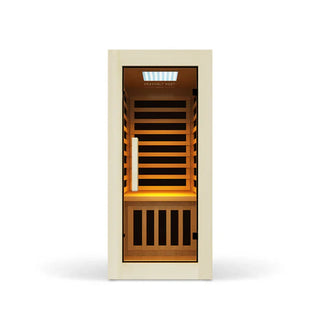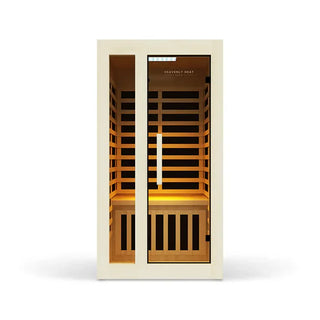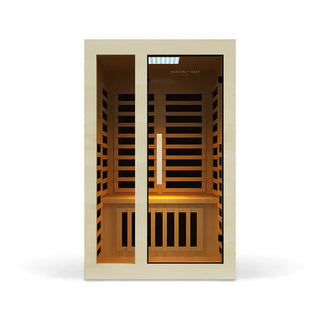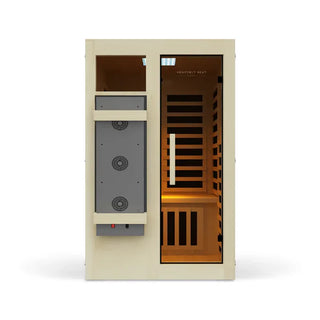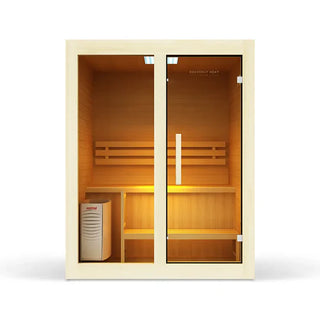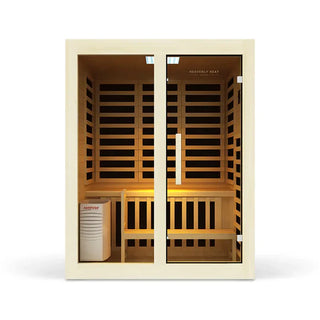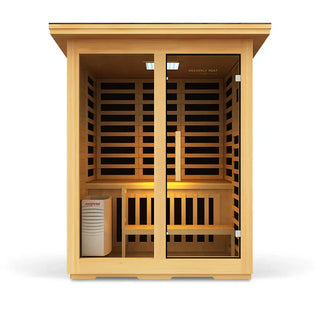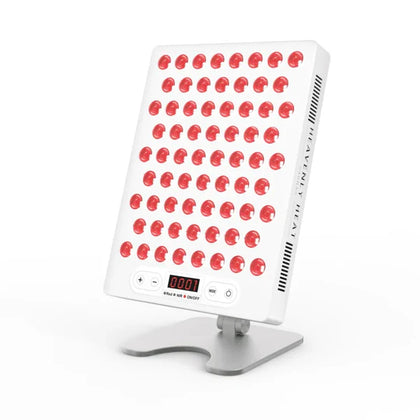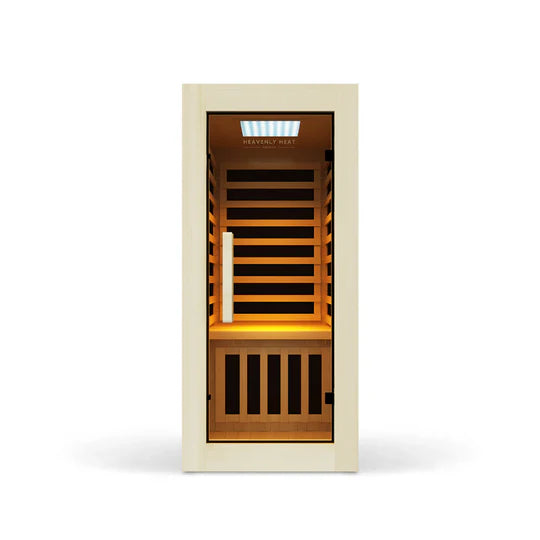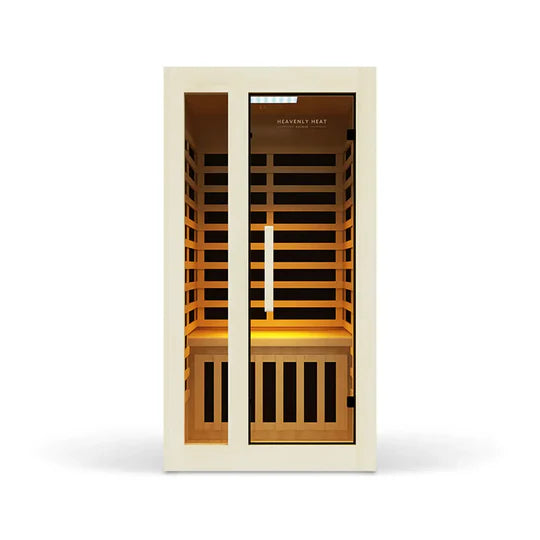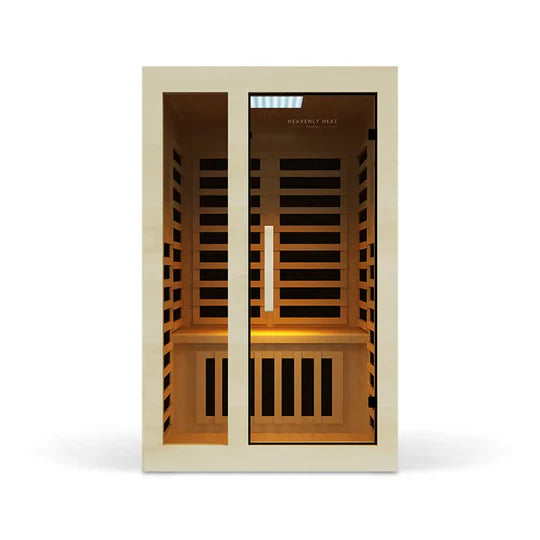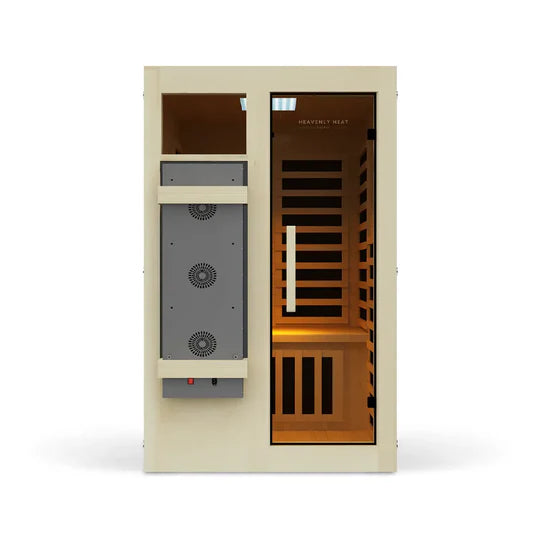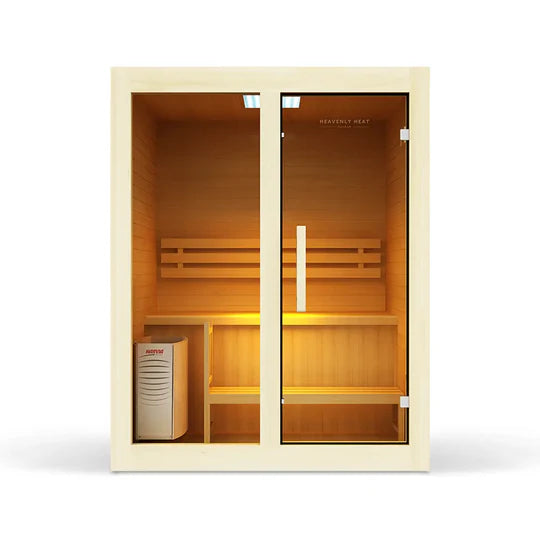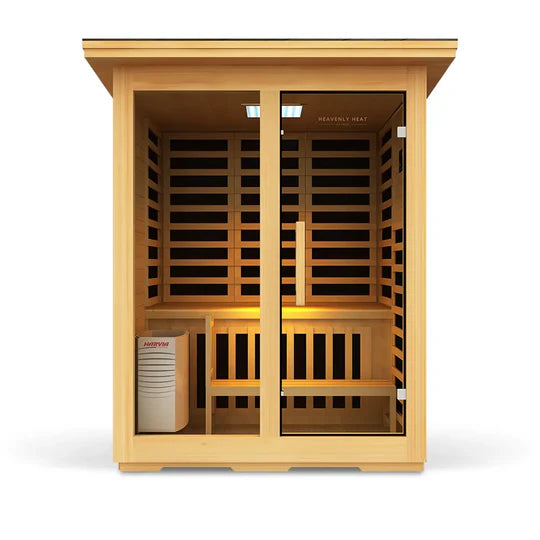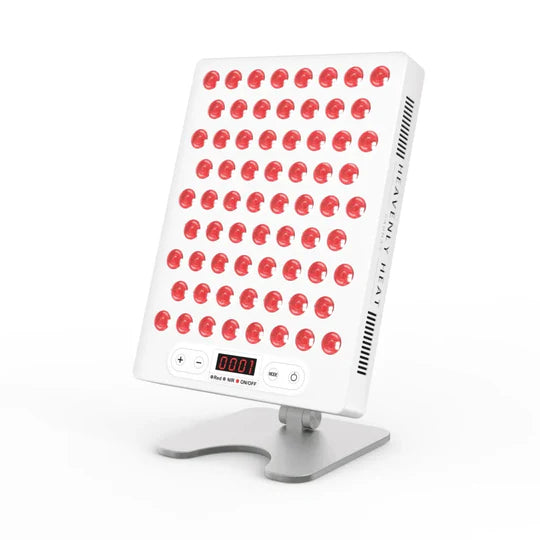Himalayan Salt in Saunas: Exploring Halotherapy Benefits for Enhanced Respiratory Health and Wellness

If you’re not getting the most out of your sauna sessions, you might be missing something essential.
Many people overlook the power of Himalayan salt, which can elevate your sauna experience.
Without it, you could be missing out on enhanced detoxification, relaxation, and air purification. Add Himalayan salt to your sauna routine for maximum health benefits and rejuvenation.
Key Takeaways
-
Himalayan salt saunas use infrared heat to provide deeper muscle relaxation at lower temperatures.
-
The negative ions released by Himalayan salt improve air quality and may help with respiratory issues.
-
Salt saunas can aid in detoxification, reduce inflammation, and improve skin health.
-
Himalayan salt walls require minimal maintenance compared to traditional saunas.
-
Combining a salt sauna with practices like yoga, aromatherapy, and red light therapy boosts relaxation and recovery.
What Is a Himalayan Salt Sauna?
- Using heat and salt together makes this sauna more powerful: A Himalayan salt sauna combines the warmth of traditional saunas with the natural benefits of Himalayan salt. The walls are made of salt blocks that release helpful negative ions when heated.
- The air feels cleaner and easier to breathe inside: When the salt is heated, it may help remove dust, allergens, and other particles from the air, making it easier to breathe and better for your lungs.
- The dry air helps you feel calm and relaxed: The salt pulls moisture out of the air, creating a dry heat that helps your body relax and your mind feel at ease.
- This kind of sauna can help clean your skin too: People use Himalayan salt saunas to help detox their skin, reduce irritation, and improve how their skin feels and looks.
- The warm glow makes the whole experience feel healing: The soft amber light from the salt blocks, along with the minerals they release, creates a peaceful, refreshing experience for both body and mind.
Himalayan Salt Saunas vs. Traditional Saunas: Key Differences
Heat Source and Technology
- Himalayan salt saunas heat your body, not the air: These saunas use infrared technology that warms your body directly, instead of heating the room around you.
- Traditional saunas heat the air to make you sweat: Electric heaters or hot stones warm up the air inside, which then raises your body temperature.
- Infrared heat goes deeper into muscles and feels gentler: The warmth from Himalayan salt saunas reaches deeper into your body, helping muscles relax with less surface heat.
- Traditional heat is more intense and works faster: Since the air gets very hot in traditional saunas, you start sweating quickly, but the heat can feel stronger and harder to handle.
- Salt saunas stay cooler but still help your body: With temperatures between 120–140°F, salt saunas offer a more comfortable experience while still giving health benefits.
- Traditional saunas get hotter and may feel more intense: These saunas can go up to 190°F, which means quicker sweating but may be tough for longer sessions.
- Lower heat in salt saunas means longer, soothing sessions: Because the heat is gentler, you can stay in longer and enjoy more relaxing and therapeutic effects.
Air Quality and Ionization
One standout feature of Himalayan salt saunas is their ability to improve air quality. The salt walls release negative ions, which neutralize pollutants and allergens.
This ionization process can improve breathing, making the air feel fresher and potentially aiding those with respiratory issues.
Traditional saunas primarily enhance circulation through heat exposure, but they do not generate the same level of ionization.
Health Benefits and Therapeutic Effects
- Breathing feels easier in a Himalayan salt sauna: Himalayan salt saunas help clear out mucus and open up your lungs, which makes it easier to breathe, especially helpful for people with asthma, allergies, or sinus problems.
- Traditional saunas help your heart and relax your muscles: Spending time in a traditional sauna can improve blood flow, ease tight muscles, and lower stress levels, giving your body a full reset.
- Warmth from both saunas eases joint pain and stiffness: Whether it’s a salt sauna or a regular one, the heat helps reduce joint pain and soothe arthritis , making movement feel easier and more comfortable.
- Infrared heat in salt saunas may calm inflammation faster: The special infrared heat used in many salt saunas can go deeper into your body, which may help reduce swelling and pain more quickly.
- Salt saunas can lift your mood and calm your mind: Many people say they feel happier and more relaxed after a salt sauna session, thanks to the peaceful glow and the natural effects of salt in the air.
- Using saunas often is mostly safe, but one study saw a tiny drop in male fertility: Regular sauna use is generally healthy, though one small study found a rare and reversible effect on male fertility, something to keep in mind but not panic about.
Humidity Levels and Moisture
Himalayan salt saunas typically maintain lower humidity, creating a dry heat environment.
This dry heat helps clear airways, while traditional saunas, especially those using steam, produce more humidity, which may aid in deep hydration.
For skin health, the moisture in traditional saunas can enhance skin hydration, while the dry air in salt saunas may help with conditions like eczema by reducing excess moisture.
Detoxification and Skin Benefits
- Sweating in salt saunas helps remove more toxins from your body: Both saunas make you sweat, but Himalayan salt saunas go a step further by using salt-rich air to help draw out deeper impurities from the skin and body.
- Traditional saunas clean your body but don’t offer salt’s skin benefits: Regular saunas still support detox through sweating , which helps your liver and kidneys, but they miss out on the extra skin-cleansing benefits that salt provides.
- Breathing salty air can calm your skin and reduce breakouts: The salt in Himalayan saunas helps reduce skin inflammation and can lead to a clearer, calmer complexion over time.
- Salt saunas keep your skin moist and may slow down aging: Salt-infused air adds hydration to the skin, and the gentle heat may boost collagen, which keeps your skin firm and youthful-looking.
Construction and Design Materials
Himalayan salt saunas incorporate salt bricks or panels into their construction, creating a unique aesthetic and functional advantage.
Traditional saunas use high-quality woods like cedar or hemlock, which offer natural durability and insulation.
The difference in materials impacts the experience, salt walls contribute to air purification, while wooden interiors in traditional saunas enhance heat retention.
Maintenance and Cleaning Requirements
Maintaining a Himalayan salt sauna involves regular wiping of surfaces and monitoring moisture levels to prevent salt degradation.
Traditional saunas require more frequent deep cleaning due to higher humidity, which can encourage mold growth.
Infrared systems in salt saunas often need less maintenance than traditional electric or wood-burning heaters.
How Himalayan Salt Reacts to Heat in a Sauna
- Himalayan salt holds heat and spreads warmth slowly: Himalayan salt doesn’t just sit there, it absorbs the sauna’s heat and slowly gives it back, making the whole space feel cozy and soothing over time.
- It stays solid in heat but gets a little damp from steam: Even when things get hot, Himalayan salt doesn’t melt like regular salt. It might feel a bit moist, though, because of the sauna’s humidity.
- Heat helps the salt release healthy minerals into the air: When warmed up, the salt lets out tiny amounts of minerals like magnesium and potassium, which can mix into the air and may make it feel fresher and cleaner.
- The longer it’s heated, the richer its color becomes: As the salt keeps soaking up heat, its pink or orange shades can get deeper, adding to the calm and relaxing look inside the sauna.
What Are Negative Ions in Himalayan Salt Saunas?
- Negative ions in the sauna give your body a natural energy boost: Inside a Himalayan salt sauna, heat makes the salt release negative ions, tiny particles that help your body feel more awake and refreshed, especially if you're drained from screens or gadgets.
- These ions help you feel calmer and think more clearly: Negative ions don’t just energize you, they also help you relax, lift your mood, and improve focus. That’s why many people feel mentally sharper and more at peace after a session.
- Science agrees that negative ions reduce stress and clean the air: Research has shown that negative ions from Himalayan salt can reduce stress and freshen the air, making the sauna not just a relaxing space, but also a healthier one.
- Breathing gets easier and your body feels lighter after the session: Studies also show that negative ions remove dust and allergens from the air. That’s why people often leave a Himalayan salt sauna breathing better and feeling lighter overall.
Safety Tips and Risks of Himalayan Salt Saunas
Check for Pre-Existing Health Conditions
- If you have heart problems or high BP, talk to your doctor first: Before using a Himalayan salt sauna, it’s important to check with a doctor if you have heart disease or high blood pressure . The heat can increase strain on your body.
- Pregnant women should not take sauna heat lightly: The high temperatures in saunas may affect pregnancy. Always check with a healthcare provider before using a sauna while pregnant.
- People with seizures should stay away from sauna heat: If you have epilepsy or a seizure disorder, it's best to avoid high heat completely, as it can increase the risk of an episode.
- If you have asthma or breathing issues, check if it’s safe for you: The salty air might help people with asthma or COPD, but it's still important to get a doctor's advice before trying it out.
Stay Hydrated Before and After Use
Proper hydration is crucial when using a Himalayan salt sauna. Dehydration can lead to dizziness, headaches, or even fainting.
Be sure to drink water before, during, and after your session to avoid these symptoms. If you feel lightheaded inside the sauna, dehydration might be the cause, step out and hydrate immediately.
Hydration ensures that your body can tolerate the heat and provides your skin with the moisture it needs.
Limit Your Session Time
Spending too much time in a Himalayan salt sauna can lead to overheating and exhaustion.
Beginners should start with shorter sessions of 10-15 minutes and gradually increase the duration as they become more accustomed to the heat.
Staying in longer than 30 minutes may increase the risk of dehydration and dizziness. If you begin to feel uncomfortable, exit the sauna immediately.
Monitor the Temperature Settings
The ideal temperature for a Himalayan salt sauna typically ranges between 120°F and 150°F.
You should monitor the temperature carefully to avoid overheating. If you feel an intense burning sensation on your skin or excessive sweating, the temperature may be too high. Make sure to adjust it accordingly or take breaks to cool down.
Avoid Using the Sauna Alone
While solo relaxation may sound appealing, using a Himalayan salt sauna alone can be risky.
If you must use the sauna alone, inform someone nearby and keep water within reach. It’s always safer to have someone present to assist in case of an emergency.
Be Cautious with Salt Sensitivities
Some individuals may have sensitivities to Himalayan salt exposure, experiencing mild irritation or allergies.
People with asthma should monitor their breathing, as salt particles may either soothe or aggravate symptoms.
If any discomfort arises, it’s best to discontinue use or consult a doctor before resuming.
Know When to Exit Immediately
Feeling dizzy, nauseous, or lightheaded are immediate red flags. If you feel weak or disoriented, exit the sauna, hydrate, and rest.
It’s always better to leave the sauna early than to risk your health. If these symptoms persist, consult a healthcare professional.
How to Set Up and Maintain a Himalayan Salt Sauna
Choosing the Right Location for Your Himalayan Salt Sauna
- A well-ventilated indoor room helps your sauna work better: Finding the right spot for your Himalayan salt sauna is crucial. Indoors , you need a well-ventilated space with enough clearance for proper heat circulation and overall safety.
- An outdoor sauna needs strong, flat ground that stays dry: If you’re setting up outdoors , make sure the foundation is stable, level, and protected from excess moisture to keep everything secure and long-lasting.
- Damp air can slowly damage your salt walls: Humidity control is essential, as too much dampness can weaken or degrade salt bricks over time, affecting the performance and lifespan of your sauna.
- Make sure there’s enough space to walk in and relax easily: Whether inside or outside, choose a location that allows easy access and enough space for comfortable movement within the sauna. It makes the whole experience much more enjoyable.
Essential Materials Needed for a Himalayan Salt Sauna
Using high-quality Himalayan salt is key to reaping the sauna’s benefits. The salt should be carefully sourced to ensure purity and optimal performance.
Investing in the right materials ensures your salt sauna remains functional and effective for years.
Installing Himalayan Salt Bricks: Step-by-Step Guide
- Clean and dry walls help bricks stick better: Before installing Himalayan salt bricks, prepare your sauna walls by ensuring they are clean and dry. A dirty or damp surface can weaken the hold of the adhesive.
- Starting from the bottom makes the wall stronger: Use a strong adhesive or mortar to attach the bricks, starting from the bottom and working your way up. This gives the bricks below time to support the ones above.
- A backing board helps keep the bricks in place: A backing board can provide extra support, preventing bricks from shifting over time, especially in a heated sauna environment.
- Checking with a level keeps the wall straight: Check each row with a level as you go to make sure everything stays even. This helps your sauna wall look neat and professional.
- Letting the glue dry fully makes the wall safe: Once installed, allow the adhesive to cure fully, typically 24 to 48 hours, before using the sauna. This drying time is important for safety and strength.
- A careful installation gives long-term results: Taking time to install the salt bricks correctly will ensure a solid and long-lasting sauna structure that doesn’t need constant repairs.
Best Heating Systems for a Himalayan Salt Sauna
- Infrared heaters are great if you want warmth that reaches deep inside your body: Infrared systems work by sending heat directly into your body instead of just warming the air. This makes them a popular choice for Himalayan salt saunas because they help with muscle relaxation and deeper healing.
- Electric heaters give stronger overall heat and are easy to control: Traditional electric heaters fill the sauna with intense, even heat. They’re easy to operate and keep the sauna at the right temperature without much effort.
- Wood-burning heaters give a natural sauna feel but need more care: If you want a more traditional, rustic experience, wood-burning stoves are a good choice, but be ready for more work in terms of setup and maintenance.
- The bigger your sauna, the more power your heater will need: Most electric heating systems use between 2 to 6 kilowatts depending on the size of the sauna. Picking the right size helps you avoid wasting energy or falling short on heat.
- A temperature between 120°F and 160°F works best in a salt sauna: Keeping the sauna in this range helps you get the full relaxation and health benefits of the Himalayan salt without overheating the space.
Proper Ventilation and Humidity Control
- Fresh air keeps your sauna from feeling heavy or damp: Good ventilation stops too much moisture from building up and brings in clean air, making the sauna feel light and fresh.
- Warmth feels better when air can still move around: Holding in heat is important, but you still need some airflow so the sauna doesn’t get too stuffy or uncomfortable.
- Right humidity helps salt do its job and protects your sauna: If it’s too dry, salt bricks won’t release the good stuff. If it’s too wet, water collects and can start causing damage.
- Vents and dehumidifiers help control moisture the smart way: Air vents let you adjust airflow, and dehumidifiers are great in areas that get too damp, keeping the sauna in balance.
- Checking for water drops often will keep mold away: Looking out for signs of condensation helps you catch problems early and keeps the sauna clean, safe, and mold-free.
Lighting Options to Enhance Your Himalayan Salt Sauna
- Soft lighting makes the sauna feel more peaceful: Lighting sets the mood in a Himalayan salt sauna. When the lights are soft and warm, the whole space feels calm and welcoming, perfect for relaxation.
- Colored lights can support your mood and energy: Chromotherapy lighting brings more than just color, it helps how you feel. Blue lights help you stay calm, while red lights give you a boost of energy.
- Salt lamps give a warm glow and look beautiful too: Himalayan salt lamps are not just for show. They light up the sauna with a gentle, cozy glow while adding to its natural and relaxing look.
- Lighting behind salt walls makes the sauna feel more special: When the salt walls are lit from behind, they glow beautifully. This not only makes the sauna look better but also helps you enjoy its calming benefits even more.
Maintaining and Cleaning Your Himalayan Salt Sauna
- Keeping the salt walls clean helps them last longer: Wiping the salt walls gently with a dry or slightly damp cloth removes dust without harming the salt blocks.
- Using natural cleaners protects your sauna: Harsh chemicals can damage the salt and affect air quality, so mild, natural products are safer and better for cleaning.
- Good airflow stops moisture from damaging the salt: When your sauna has proper ventilation, it prevents moisture buildup that can weaken the salt walls. A dehumidifier can help if the air feels damp.
- Deep cleaning once in a while keeps things fresh: Giving your sauna a more thorough clean every few months removes buildup and keeps everything in great shape.
- Regular care makes your sauna last for years: By staying consistent with simple cleaning and maintenance , your sauna will stay in top condition and continue to give you all its relaxing benefits.
Can You Combine a Himalayan Salt Sauna With Other Wellness Practices?
Aromatherapy
Aromatherapy can enhance the relaxation and health benefits of a Himalayan salt sauna.
Essential oils such as lavender, eucalyptus, and peppermint can be diffused into the air, providing both physical and emotional benefits.
Diffusing these oils can be done by placing a few drops in a bowl of water near the heat source or using sauna-safe diffusers.
Meditation and Breathwork
- Sitting in the salt sauna helps you relax and meditate better: The warm, ionized air in a Himalayan salt sauna naturally calms your body and mind, making it easier to stay focused during meditation and let go of outside distractions.
- The calm atmosphere inside supports both silent and guided meditation: Whether you’re quietly sitting with your thoughts or following a guided voice, the peaceful environment inside the salt sauna makes any form of meditation feel deeper and more effective.
- Breathing exercises feel smoother because your lungs open up: The warm, salty air helps clear your airways and improves how you breathe, making breathwork practices feel easier and more refreshing for your body.
- Doing deep breathing in the sauna gives more health benefits: Techniques like belly breathing or alternate nostril breathing work even better in a salt sauna, helping you take in more oxygen, feel more energized, and support your lung health.
Cold Therapy
Cold therapy and a Himalayan salt sauna complement each other perfectly. The combination of heat and cold improves circulation, reduces inflammation, and enhances muscle recovery.
Alternating between the sauna and cold therapy, such as ice baths or cold showers, boosts detoxification and strengthens the immune system.
Yoga and Stretching
Yoga and stretching pair well with a Himalayan salt sauna, helping to loosen tight muscles and improve flexibility.
Post-sauna stretching takes advantage of the heat’s ability to relax muscles, making movements easier and reducing the risk of injury.
Practicing gentle yoga after a sauna session can provide additional relaxation and stress relief.
Massage Therapy
Massage therapy enhances the effects of a Himalayan salt sauna by improving circulation and promoting relaxation.
The combination of heat and massage improves circulation, reduces stress, and enhances overall well-being.
Consider a massage after your sauna session for a complete relaxation experience.
Sound Therapy
- Sound therapy feels even more relaxing inside a salt sauna: Sound therapy inside a Himalayan salt sauna creates a deeply immersive wellness experience, making the session feel more calming and peaceful.
- The salt in the air makes soothing sounds work better: The salt-rich environment boosts the effects of gentle sounds, helping calm your nervous system and making it easier to focus and be present.
- Soft music or nature sounds are perfect in the sauna: Using soft music, nature sounds, or binaural beats can set the right mood in a salt sauna without feeling too intense or distracting.
- Low volume sound is completely safe in a heated space: As long as the volume stays comfortable, sound therapy is safe to use in the heat of a salt sauna and won’t disturb your relaxation.
- Adding sound makes sauna sessions feel more meditative: Including sound therapy in your routine helps you get deeper into relaxation and can reduce stress more effectively.
- Wireless speakers and apps make sound therapy easy to use: With Bluetooth speakers or meditation apps, it’s simple to play calming sounds and enjoy a personal, soothing experience every time.
Red Light Therapy
Red light therapy can be safely combined with a Himalayan salt sauna for enhanced relaxation and recovery.
The combination of red light and Himalayan salt sauna can improve sleep, reduce inflammation, and support overall wellness. This pairing can also aid in skin health and muscle recovery.


